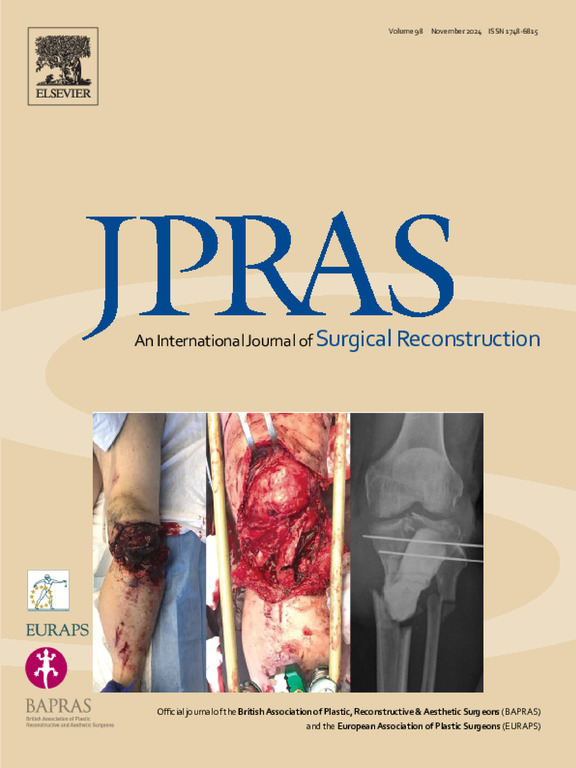Immediate versus delayed contralateral symmetrisation in autologous breast reconstruction: A comparative study
IF 2
3区 医学
Q2 SURGERY
Journal of Plastic Reconstructive and Aesthetic Surgery
Pub Date : 2025-03-17
DOI:10.1016/j.bjps.2025.03.028
引用次数: 0
Abstract
Introduction
The optimal timing for contralateral breast symmetrisation in autologous breast reconstruction remains a controversial and under-researched topic, even though approximately 50% of patients will undergo contralateral symmetrisation procedures at some point in their reconstructive journey.
Methods
We conducted a retrospective comparative study including patients who underwent unilateral autologous breast reconstruction with either immediate or delayed contralateral breast symmetrisation from January 2018 to December 2022 at the Queen Victoria Hospital. Data were collected on patient age, timing of breast reconstruction and symmetrisation, flap type, operative time of the reconstructive procedure, length of hospital stay, complications requiring return-to-theatre, total number of surgical procedures and length of the reconstructive journey.
Results
Overall, 417 patients were divided into two groups based on the timing of contralateral symmetrisation (Group 1: 299 patients with delayed symmetrisation and Group 2: 118 patients with immediate symmetrisation). The two groups were comparable in terms of age and surgical characteristics. Although immediate symmetrisation significantly increased the operative time of the reconstructive procedure, there was no increase in the rate of complications requiring return-to-theatre or in the length of hospital stay. Patients who underwent immediate symmetrisation had a significantly lower total number of surgical procedures with a shorter reconstructive journey.
Conclusion
Our study showed that immediate contralateral breast symmetrisation is safe, reduces the total number of surgical procedures and shortens the reconstructive journey for patients undergoing unilateral autologous breast reconstruction.
自体乳房重建即刻与延迟对侧对称:一项比较研究
自体乳房重建中对侧乳房对称的最佳时机仍然是一个有争议和研究不足的话题,尽管大约50%的患者在重建过程中的某个时候会接受对侧乳房对称手术。方法:我们对2018年1月至2022年12月在维多利亚女王医院接受单侧自体乳房重建的患者进行回顾性比较研究,包括立即或延迟对侧乳房对称。收集的数据包括患者年龄、乳房重建和对称的时间、皮瓣类型、重建手术的手术时间、住院时间、需要返回手术室的并发症、手术总数和重建路程的长度。结果417例患者根据对侧对称时间分为2组(1组299例延迟对称,2组118例立即对称)。两组在年龄和手术特点上具有可比性。虽然立即对称显著增加了重建手术的手术时间,但需要返回手术室的并发症发生率或住院时间没有增加。接受即时对称的患者手术次数明显减少,重建时间较短。结论对侧乳房即刻对称是安全的,减少了手术次数,缩短了单侧自体乳房再造术的时间。
本文章由计算机程序翻译,如有差异,请以英文原文为准。
求助全文
约1分钟内获得全文
求助全文
来源期刊
CiteScore
3.10
自引率
11.10%
发文量
578
审稿时长
3.5 months
期刊介绍:
JPRAS An International Journal of Surgical Reconstruction is one of the world''s leading international journals, covering all the reconstructive and aesthetic aspects of plastic surgery.
The journal presents the latest surgical procedures with audit and outcome studies of new and established techniques in plastic surgery including: cleft lip and palate and other heads and neck surgery, hand surgery, lower limb trauma, burns, skin cancer, breast surgery and aesthetic surgery.

 求助内容:
求助内容: 应助结果提醒方式:
应助结果提醒方式:


